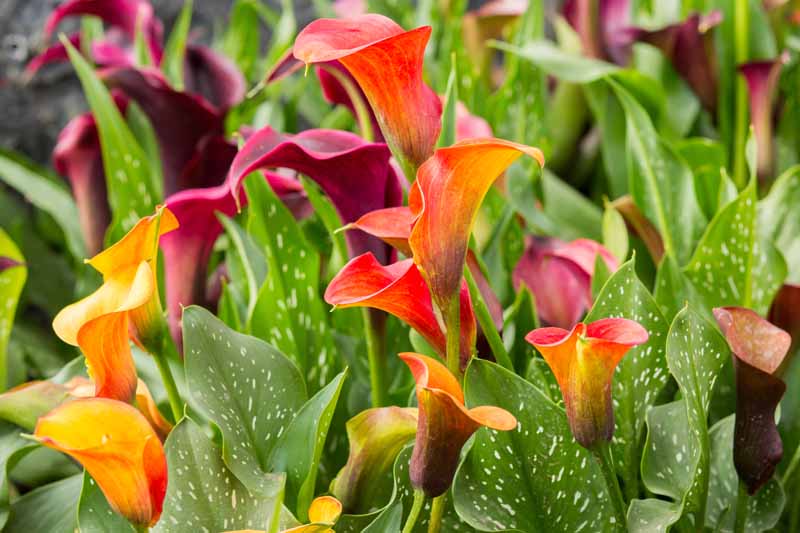Calla lilies are gorgeous flowers that bloom in spring and early summer. Their funnel-shaped blooms come in colors like white pink yellow, and purple on long, smooth stems. But what should you do when these showy flowers fade?
Proper aftercare is crucial for calla lilies to thrive year after year. Here are some tips on caring for calla lilies after blooming:
Remove Spent Blooms
Unlike some plants where deadheading encourages reblooming calla lilies bloom only once per season. However you should still remove spent flowers. Calla blooms don’t fall off on their own. The blooms turn green and become tubular as they fade. Snip these unsightly blooms off with pruners. Removing old blooms keeps your plant looking tidy and prevents disease.
Continue Watering
After blooming finishes, continue caring for the foliage. Keep watering your calla lilies while the leaves remain green. Water when the top inch of soil becomes dry. Avoid overwatering, which can lead to root rot. Reduce watering frequency as the leaves start yellowing. Proper moisture prevents leaves from drooping prematurely.
Apply Fertilizer
Feed your calla lilies with a balanced liquid fertilizer every 2-4 weeks after blooming ends. The nutrients support the plant while it sends energy to the rhizomes. Stop fertilizing once the leaves start turning yellow. Fertilizing late in the season can spur growth prone to frost damage.
Monitor for Pests
Inspect calla lily leaves and flowers periodically for signs of infestation. Aphids, thrips, and mites can attack lilies. Treat any pests you spot with horticultural oil or insecticidal soap sprays. This protects the plant’s health going into dormancy.
Cut Back Leaves
In mid to late summer, the calla lily’s leaves will turn yellow or brown and become dry. Once the foliage declines, use sterilized pruners to trim the leaves back near the base of the plant. Removing dead leaves reduces the risk of diseases.
Dig Up Rhizomes
After the first frost, dig up the underground rhizomes. Carefully loosen the soil and lift out the rhizomes. Remove any remaining foliage. Gently brush off dirt but don’t wash the rhizomes. Washing removes the protective skin coating.
Dry and Store Rhizomes
Place the dug rhizomes in a dry, well-ventilated area for 1-2 weeks. Turn them periodically. This allows them to cure properly. Once dried, put the rhizomes in peat moss or vermiculite. Store in a cool place around 50-60°F over winter. The dry medium prevents rotting.
Repot Container Plants
For calla lilies grown in pots, bring the containers indoors before frost hits. Place in a sunny spot and keep watering lightly until the leaves die back. Repot in fresh soil every 2-3 years in early spring.
Water Sparingly
Check rhizome storage medium periodically and lightly water if it becomes completely dry. Some moisture prevents shriveling. Avoid overwatering, which can quickly lead to rot and disease.
Discard Damaged Rhizomes
Inspect overwintering rhizomes occasionally. Discard any that show signs of rot or damage. Diseased rhizomes can spread problems when replanted.
Replant in Spring
In early spring after the threat of frost has passed, replant calla lily rhizomes outdoors. Dig holes the same depth as the rhizome and 2 feet apart. Place rhizomes with the sprouting eyes up and cover with soil.
With proper aftercare and overwintering, your calla lilies will return healthier than ever each growing season! The above steps help nurture the rhizomes so they survive dormancy to produce stunning blooms year after year.
How to Deadhead Calla Lilies
Deadheading, or removing spent blooms, helps keep calla lily plants looking attractive. Here are simple instructions for deadheading calla lilies:
-
Use garden shears or scissors to cut off the dying flower stalk close to the base of the plant.
-
Make sure no bare stem is sticking out through the leaves. However, leave a short stem near the base.
-
This is the best method for removing flowers to use in bouquets while keeping the plant healthy.
-
Remove spent blooms as soon as you notice the blossom fading or turning green and tubular.
-
Deadheading improves the appearance of the foliage and prevents diseases.
FAQ About Caring for Calla Lilies After Blooming
Here are answers to some frequently asked questions about calla lily aftercare:
Should calla lilies be cut back after flowering?
You may cut the flower stalk to the ground but leave the foliage for next year’s blooms. Also, if your plant has happily returned each year without issues, simply continue care as usual.
How do you save calla lilies for next year?
In cooler climates (zones 3-7), dig up the tubers before the first frost and store them over winter before replanting next spring.
Do calla lilies bloom more than once?
Yes, calla lilies are perennial plants that bloom year after year in zones 8-10. In cooler zones, extra care is needed in winter.
Are you supposed to deadhead calla lilies?
Yes, it’s recommended to remove spent blooms by cutting the flower stalks to the ground, keeping the plant looking tidy.
Properly caring for calla lilies after blooming and overwintering the rhizomes will ensure magnificent flowers for years to come! Follow these tips and enjoy your calla lilies season after season.

After your lilies have flowered, you need to….
Cut the flower heads off your lilies (as you’ve done), allow the foliage to die back naturally. Do not be tempted to cut the stem back until stems become hollow and brown. This will then feed the bulb for next year’s flowering. Leave the bulbs in the ground or in your pots as they like a cold dormant phase throughout the winter (they can tolerate -20c). Ensure they have plenty of drainage so they don’t get waterlogged as this will cause the bulbs to rot. You can tilt the pots on their side or place under shelter to prevent this. After a few years, you may find you need to divide your lily bulbs and replant them all.
